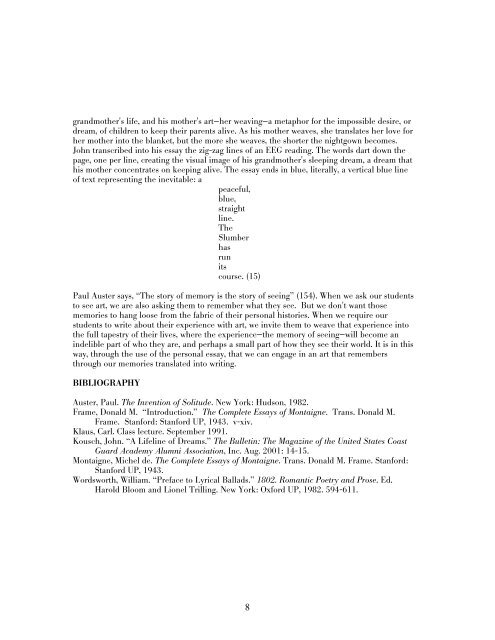SECTION 1 - via - School of Visual Arts
SECTION 1 - via - School of Visual Arts
SECTION 1 - via - School of Visual Arts
Create successful ePaper yourself
Turn your PDF publications into a flip-book with our unique Google optimized e-Paper software.
grandmother's life, and his mother's art—her weaving—a metaphor for the impossible desire, or<br />
dream, <strong>of</strong> children to keep their parents alive. As his mother weaves, she translates her love for<br />
her mother into the blanket, but the more she weaves, the shorter the nightgown becomes.<br />
John transcribed into his essay the zig-zag lines <strong>of</strong> an EEG reading. The words dart down the<br />
page, one per line, creating the visual image <strong>of</strong> his grandmother's sleeping dream, a dream that<br />
his mother concentrates on keeping alive. The essay ends in blue, literally, a vertical blue line<br />
<strong>of</strong> text representing the inevitable: a<br />
peaceful,<br />
blue,<br />
straight<br />
line.<br />
The<br />
Slumber<br />
has<br />
run<br />
its<br />
course. (15)<br />
Paul Auster says, “The story <strong>of</strong> memory is the story <strong>of</strong> seeing” (154). When we ask our students<br />
to see art, we are also asking them to remember what they see. But we don't want those<br />
memories to hang loose from the fabric <strong>of</strong> their personal histories. When we require our<br />
students to write about their experience with art, we invite them to weave that experience into<br />
the full tapestry <strong>of</strong> their lives, where the experience—the memory <strong>of</strong> seeing—will become an<br />
indelible part <strong>of</strong> who they are, and perhaps a small part <strong>of</strong> how they see their world. It is in this<br />
way, through the use <strong>of</strong> the personal essay, that we can engage in an art that remembers<br />
through our memories translated into writing.<br />
BIBLIOGRAPHY<br />
Auster, Paul. The Invention <strong>of</strong> Solitude. New York: Hudson, 1982.<br />
Frame, Donald M. “Introduction.” The Complete Essays <strong>of</strong> Montaigne. Trans. Donald M.<br />
Frame. Stanford: Stanford UP, 1943. v-xiv.<br />
Klaus, Carl. Class lecture. September 1991.<br />
Kousch, John. “A Lifeline <strong>of</strong> Dreams.” The Bulletin: The Magazine <strong>of</strong> the United States Coast<br />
Guard Academy Alumni Association, Inc. Aug. 2001: 14-15.<br />
Montaigne, Michel de. The Complete Essays <strong>of</strong> Montaigne. Trans. Donald M. Frame. Stanford:<br />
Stanford UP, 1943.<br />
Wordsworth, William. “Preface to Lyrical Ballads.” 1802. Romantic Poetry and Prose. Ed.<br />
Harold Bloom and Lionel Trilling. New York: Oxford UP, 1982. 594-611.<br />
8








